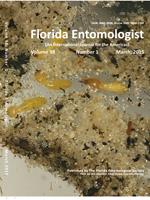The male of Canaea bibarra (Chu & Wang, 1991) (Lepidoptera: Thyrididae: Striglininae) was discovered in Hainan, China for the first time. The male adult is very similar to female except for the paler ground color and monopectinate antenna. The male adults and the genitalia are described, with notes on their distribution and how they differ from related species.
The genus Canaea Walker, 1864 (Lepidoptera: Thyrididae: Striglininae) was revised by Whalley (1971) on a worldwide basis, and 10 species with 10 subspecies were enumerated from West Malaysia to New Caledonia and the eastern coast of Australia. Chu & Wang (1991) described a new genus and species of striglinine moth, Phthina bibarra Chu & Wang, 1991, from Hainan on the basis of 3 female specimens. Robinson et al. (1994) illustrated Canaea semitessellata Walker, 1864 and Canaea sp., and added China (Hainan) to the distributional range of Canaea, but they did not refer to Phthina bibarra. In the checklist of Australian Lepidoptera, the genus Phthina Chu & Wang, 1991 was synonymized with Canaea by Shaffer & Nielsen (1996) without any comments.
In the course of a research project on the lepidopteran fauna of Hainan, we were able to collect males of Canaea bibarra (Chu & Wang 1991) in Jianfengling National Nature Reserve and Yinggeling Nature Reserve, Hainan Province, China. In addition, 2 males of this same species were collected in central Vietnam in joint research by the National Science Museum, Tokyo (NSMT) and the Institute of Ecology and Biological Resources, Hanoi (IEBR). In this paper, we describe features of the male for the first time.
Canaea bibarra (Chu & Wang, 1991) (Figs. 1–3)
Phthina bibarra Chu et Wang 1991: 340, 346, Fig. 20, pl. 2, Fig. 20; Zhu (Chu) & Wang 1996: 234-236, Fig. 186, pl. 15, Fig. 10.
SPECIMENS EXAMINED
CHINA, Hainan, Jianfengling National Nature Reserve, 900 m, 1 male, 23. V. 2004, Min Wang leg. Yinggeling Nature Reserve, 500 m, 1 male, 26. VII. 2005, Liu-Sheng Chen leg. (in SCAU). VIETNAM, Thua Thien Hue, Back Ma, 1,200 m, 2 males, 7–11. VI. 2002, Mamoru Owada leg. (in NSMT and IEBR).
MALE ADULT
Wingspan 27–30 mm. Head greyish white; antenna monopectinate, yellowish brown; labial palpus long, greyish brown, upturned. Thorax and tegula with yellowish brown scales. Abdomen yellowish brown, underside paler, fore tibia with furcella, hind tibia with two pairs of spurs. Forewing ground colour yellowish ochre, distal half brown with some irregular semitransparent spots, basal half whitish brown, middle part with an greyish brown stripe, near the stripe with a small crescent-shaped greyish brown stripe, oval-shaped semitranaparent spot in the middle of these two stripes; apical angle slightly round, fringe scales grey.
Hind wing with some irregular pale yellowish white spots, and two greyish brown stripes, one is longer in the middle, another is shorter near the outer margin of hindwing; basal area yellowish white, with some black brown lines formed as reticulation. Underside of both forewing and hindwing paler than upperside.
Male genitalia: Uncus long, tenuous, apex pointed; gnathos broad, just meeting in middle, not merging; tegumen broad, rectangleshaped; valva broad basally, tapering, apex slightly pointed, basal part slightly invaginate; costa sclerotized, with three processes, inner one long triangle, strongly toothed, central one short, and outer one longest, smooth, with Y-shaped apex; sacculus broad, with an arc-shaped incision, basala process of sacculus long, sclerotized; saccus exposure, V-shaped; aedeagus slightly slender, shrinking at middle, vesica membranous exposure.
DISTRIBUTION
China (Hainan), Vietnam (Thua Thien Hue) new record.
NOTES
The wing pattern of males from Hainan and Vietnam are identical with those of females (Chu & Wang 1991, Fig. 20; Zhu (Chu) & Wang 1996, pl. 15, Fig. 10), and the ground color is paler. This species can be distinguished from other Canaea species by the oval-shaped semitranaparent spot in the middle of forewing. Jianfeng, the type locality of C. bibarra, is located in the southwestern coast of Hainan, and is distant ca. 280 km from Back Ma, Thua Thien Hue, across the sea of Tonkin Bay. The genus Canaea has not been recorded from Vietnam (Konvička et al. 1998).
The structure of male genitalia of C. bibarra is similar to that of C. ignotalis (Röber, 1891) from Sulawesi, Salajar and Buru, but distinguished from the latter by the longer uncus, the shape of sclerotized processes of costa, and the membranous vesica of aedeagus. The sclerotized patch in corpus bursae of female genitalia of C. bibarra (Chu & Wang 1991, Fig. 20e) lacks rows of sclerotized plates, which are present (Whalley 1991, Figs. 50, 52) in C. ignotalis.
Acknowledgments
We are very grateful to Dr. Liu-sheng Chen, Shihezi University, for collecting the material in Hainan. Mamoru Owada expresses his hearty thanks to Dr. Ta Huy Thinh, IEBR, Hanoi, for his kind cooperation to the field researches in Vietnam.






